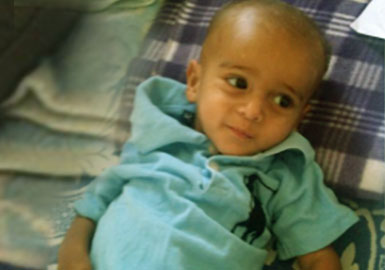One year into the crisis, ongoing clashes and increased cost of fuel force pharmaceutical plants in Rural Aleppo, Homs and Rural Damascus to shut down. As a result, the country’s local production of medicines was reduced by 90%, depriving more than half of the population of access to medicines and medical treatment.
6-year-old Joseph is diagnosed with leukaemia, nine months after he and his family fled their hometown in Dara’a to stay with his uncle in Damascus. Due to shortages in medicines for cancer patients, Joseph is unable to continue his treatment. “I do not want my child to die,” said his father. “We have not been able to secure his medicine for 3 months now,” he added. “I want him to live for a long time, he is only six … but he is strong and a true fighter for his life”.
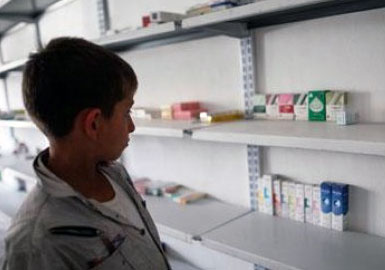
Thousands of people are injured every month as a result of the fighting. Hospitals are overwhelmed with increasing numbers of trauma care patients and report shortages in trauma and surgical medicines and supplies.
3-year old Khalid* is walking in the street when a blast erupts, destroying buildings around him and trapping him under the rubble. He is found by passers-by, who take him and tens of other injured civilians to the closest functioning hospital. Khalid has lost one of his legs and part of his pelvic area. Fortunately, a surgeon is available at the hospital and able to control the bleeding and perform an emergency surgical procedure. While Khalid is able to receive life-saving care, others are not so fortunate. 4-year old Hala* is admitted in a critical condition. Hospital workers are unable to save her, and less than 24 hours later, Hala passes away.

The conflict is taking its toll on the Syrian population, and more people are showing signs of mental health disorders, ranging from mild to severe. The situation is aggravated by a lack of mental health specialists.
30-year-old Noor suffers from schizophrenia. He lives with his family in Barzeh, a suburb of the Syrian capital and the scene of fighting since 2012. One day, his family find him on the roof, his face scratched by a sniper bullet. Noor is admitted for psychiatric treatment at Ibn Rushd Hospital on the outskirts of Damascus, the only facility in Syria where people with acute psychiatric conditions can receive treatment. He and his family are among the fortunate few who are able to access such care.
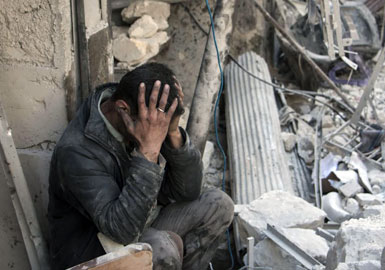
Due to shortages in medicines for diabetes, kidney disease, heart disease and cancer, people with chronic diseases are at increased risk dying of complications that are easily managed under normal circumstances.
9-year-old Omar from Aleppo is diagnosed with type 1 diabetes. Every month, he and his mother head to the nearest primary health care centre to collect his insulin supply. However, access to insulin is not easy as Omar lives in Jabal Samaan district, a conflict-ridden area where market prices are high and cold storage for other medicines is not always available. As Omar grows and needs higher doses of insulin to control his diabetes, shortages will affect his ability to receive the required treatment every month.
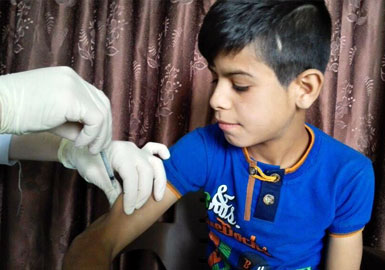
More than half of the country’s public hospitals and primary health care centres have either closed or are only partially functioning, and almost two thirds of all health professionals have fled the country. Those that remain are at constant risk of attack.
Dr Hatem Abu Yazan, the General Director of the Children’s Specialised Hospital in Al Shaa’ar in eastern Aleppo City, is on duty in the hospital’s neonatal section on the first floor when he hears the sound of an airstrike. He does not pay much attention until he sees the doors collapse and windows shatter. Together with a nurse and another doctor, he lifts 9 babies from their incubators and carries them to the basement, where he knows they will be safe. He waits for 10 minutes for the attack to subside, and then runs back up to bring the incubators down to the basement, so that the babies are not at risk in case of another attack.
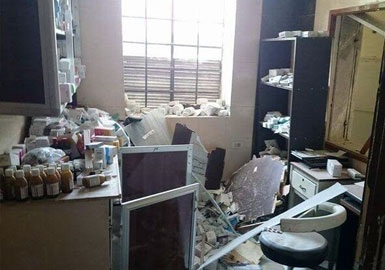
Amid food shortages and limited access to health care services, child malnutrition rates are increasing. An estimated 4.3 million boys and girls under the age of 5 are in need of nutrition services, including 73 000 children who are acutely malnourished.
Due to severe clashes in their home town, 12-month-old Samer*, his mother and disabled father fled to Hama governorate, where they live in a state of exhaustion, depression and starvation. Soon after, Samer is admitted to the malnutrition treatment centre in Hama weighing 5.8 kilogrammes (less than 13 pounds). He is diagnosed with severe acute malnutrition, pneumonia and breathing difficulties. Samer undergoes treatment as part of the centre’s management of severe acute malnutrition programme. After 10 days, his weight increases and the pneumonia and breathing difficulties are completely treated.
